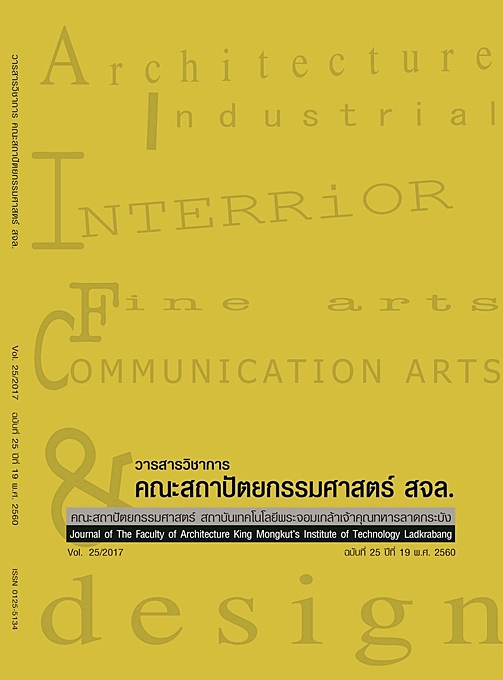การออกแบบสถาปัตยกรรมและพื้นที่สำหรับเด็กปฐมวัยตามแนวการสอนแบบมอนเตสซอรี (Architectural and Spatial Designs for Young Children from Montessori Approach)
Main Article Content
Abstract
บทคัดย่อ
การศึกษาชิ้นนี้เป็นการค้นคว้า รวบรวม วิเคราะห์ และสังเคราะห์องค์ความรู้ทางด้านการออกแบบสถาปัตยกรรมและสิ่งแวดล้อมสำหรับเด็กปฐมวัยตามแนวการสอนแบบมอนเตสเซอรี โดยมีวัตถุประสงค์หลัก คือ การประมวลองค์ความรู้และสร้างฐานข้อมูลด้านการออกแบบสถาปัตยกรรมและพื้นที่สำหรับเด็กปฐมวัย ตามแนวการสอนแบบมอนเตสซอรี สาระ และกรรมวิธีการศึกษาของงานชิ้นนี้ ตั้งอยู่บนพื้นฐานของการวิเคราะห์เอกสาร (Document Analysis) โดยมีกระบวนการการศึกษา 3 ขั้นตอน คือ 1) การระบุเป้าหมายทางการศึกษาที่ชัดเจน 2) การศึกษาถึงความเป็นไปได้ที่สภาพแวดล้อมทางกายภาพจะช่วยพัฒนาไปสู่เป้าหมายทางการศึกษา และ 3) การแปลงเป้าหมายในลักษณะของแนวคิดการจัดการไปสู่การออกแบบทางกายภาพ ผลการศึกษาแสดงให้เห็นถึงประเด็นสำคัญของการออกแบบพื้นที่ตามแนวทางมอนเตสซอรี นั่นคือ สภาพแวดล้อมมีความสำคัญต่อการเรียนรู้แบบมอนเตสซอรี โดยสภาพแวดล้อมถือเป็นองค์ประกอบสำคัญที่ช่วยให้การเรียนรู้บรรลุเป้าหมายแนวทางของมอนเตสซอรีต้องการรูปแบบสภาพแวดล้อมที่ถูกจัดเตรียมอย่างมีจุดมุ่งหมาย (Prepared Environment) ที่สัมพันธ์กับกิจกรรมของเด็กซึ่งจะเกิดขึ้นอย่างอิสระและเป็นธรรมชาติภายในสภาพแวดล้อมนั้น ทั้งนี้ เพื่อให้เด็กมีอิสระในการเลือกมีอิสระในตนเอง และเพื่อให้เด็กได้เรียนรู้ ค้นพบ เกิดความตระหนัก และพัฒนาได้ด้วยตนเอง
คำสำคัญ: สถาปัตยกรรมสำหรับเด็ก สภาพแวดล้อมสำหรับเด็ก เด็กปฐมวัย มอนเตสซอรี
Abstract
This study searches for the knowledge about architectural and spatial designs for young children led
by Montessori approach. It aims to compile the relevant information and then to create a data base that could assist the architectural and spatial designs following the Montessori philosophy. Based on a document analysis, the study process consists of 1) identification of the educational goals, 2) recognition of the potential which the physical environment has for achieving the goals, and 3) phrasing the goals in operative concepts that can be translated into physical design. The result of the study displays the main ideas of the architectural and spatial designs following the Montessori approach. According to Montessori, environment is significant in children’s learning processes and “prepared environment” is a key to provoke children’s freedom to choose, to be independent, and ultimately, to discover, to have awareness and to develop all by themselves.
Keywords: Architectural and Spatial Designs for Children, Children’s Space, Early Childhood, Montessori
Article Details
This work is licensed under a Creative Commons Attribution-NonCommercial-ShareAlike 4.0 International License.
Copyright Transfer Statement
The copyright of this article is transferred to Journal of The Faculty of Architecture King Mongkut's Institute of Technology Ladkrabang with effect if and when the article is accepted for publication. The copyright transfer covers the exclusive right to reproduce and distribute the article, including reprints, translations, photographic reproductions, electronic form (offline, online) or any other reproductions of similar nature.
The author warrants that this contribution is original and that he/she has full power to make this grant. The author signs for and accepts responsibility for releasing this material on behalf of any and all co-authors.


